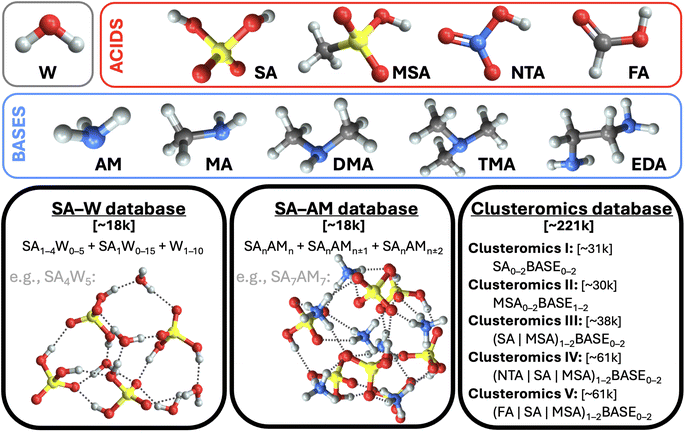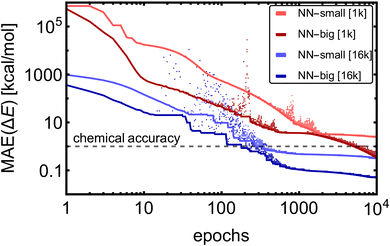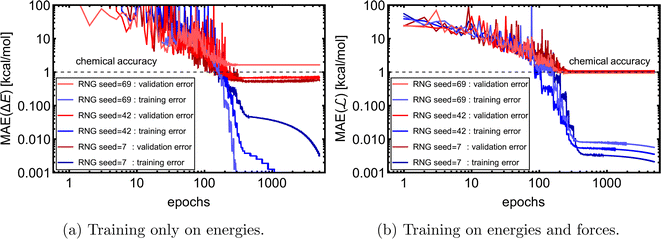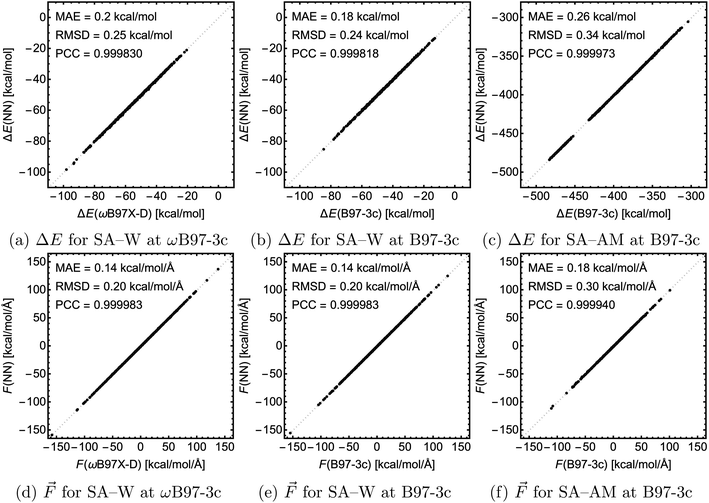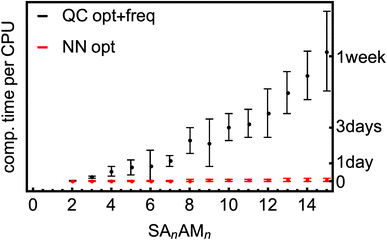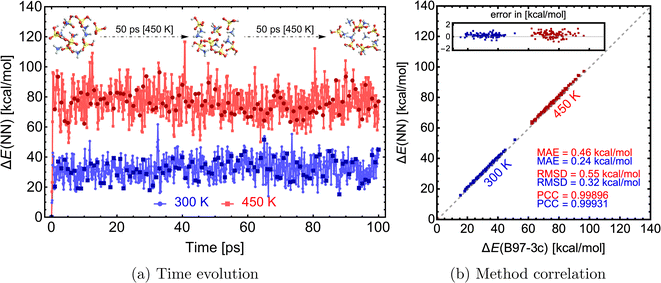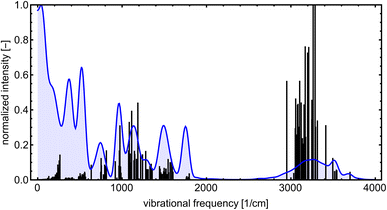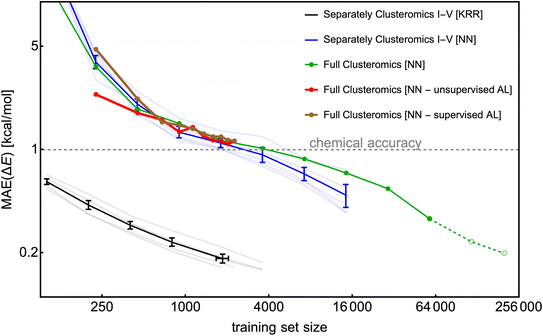 Open Access Article
Open Access ArticleCreative Commons Attribution 3.0 Unported Licence
Accurate modeling of the potential energy surface of atmospheric molecular clusters boosted by neural networks†
Jakub
Kubečka
 *a,
Daniel
Ayoubi
*a,
Daniel
Ayoubi
 a,
Zeyuan
Tang
a,
Zeyuan
Tang
 b,
Yosef
Knattrup
b,
Yosef
Knattrup
 a,
Morten
Engsvang
a,
Morten
Engsvang
 a,
Haide
Wu
a,
Haide
Wu
 a and
Jonas
Elm
a and
Jonas
Elm
 a
a
aDepartment of Chemistry, Aarhus University, Langelandsgade 140, 8000 Aarhus C, Denmark. E-mail: ja-kub-ecka@chem.au.dk; Tel: +420 724946622
bCenter for Interstellar Catalysis, Department of Physics and Astronomy, Aarhus University, Ny Munkegade 120, 8000 Aarhus C, Denmark
First published on 13th August 2024
Abstract
The computational cost of accurate quantum chemistry (QC) calculations of large molecular systems can often be unbearably high. Machine learning offers a lower computational cost compared to QC methods while maintaining their accuracy. In this study, we employ the polarizable atom interaction neural network (PaiNN) architecture to train and model the potential energy surface of molecular clusters relevant to atmospheric new particle formation, such as sulfuric acid–ammonia clusters. We compare the differences between PaiNN and previous kernel ridge regression modeling for the Clusteromics I–V data sets. We showcase three models capable of predicting electronic binding energies and interatomic forces with mean absolute errors of <0.3 kcal mol−1 and <0.2 kcal mol−1 Å−1, respectively. Furthermore, we demonstrate that the error of the modeled properties remains below the chemical accuracy of 1 kcal mol−1 even for clusters vastly larger than those in the training database (up to (H2SO4)15(NH3)15 clusters, containing 30 molecules). Consequently, we emphasize the potential applications of these models for faster and more thorough configurational sampling and for boosting molecular dynamics studies of large atmospheric molecular clusters.
Environmental significanceAtmospheric aerosol particles significantly impact human health, atmospheric chemistry, and climate. Yet, aerosol processes remain poorly understood, introducing major uncertainties in climate models. New particle formation is a process driven by formation of stable molecular clusters that grow into aerosols. While theoretical and experimental studies qualitatively agree for simple systems, massive errors are observed in complex systems. Unfortunately, accurate quantum chemical calculations for these systems are computationally demanding. However, machine learning can replicate those at a fraction of the computational cost. We trained neural networks on various systems and demonstrated their effectiveness for large molecular clusters. This is a significant step toward large-scale, ab initio modeling of atmospheric nucleation that will potentially reduce uncertainties in climate predictions. |
1 Introduction
The formation and growth of molecular clusters in the atmosphere drive the gas-to-particle conversion process known as new particle formation (NPF). These aerosols contribute to a net cooling effect on the Earth.1 Almost 50% of newly formed aerosols act as cloud condensation nuclei (CCN), enhancing cloud formation and the albedo effect.2,3 Additionally, due to their tiny size, aerosols can transport various molecules, viruses, and bacteria deeply into the respiratory system, posing health risks.4–6While the exact chemical species relevant to aerosol formation mechanisms are poorly understood, many studies present insight into the most relevant components, such as sulfuric acid, ammonia, dimethylamine, and various oxidation products of volatile organic compounds.7–10 Other studies have employed computational quantum chemistry (QC) and modeling to investigate the first crucial steps of formation mechanisms; molecular cluster formation.11–13 One of the main paths is through stable inorganic acid–base salts. Accurate QC methods are required to capture the chemistry of common acid–base clusters, which are stabilized by proton transfer; a bond-breaking/-formation reaction. However, these methods are computationally expensive and scale significantly with molecular size, which often limits computational studies to small clusters, typically with less than 10 molecules. To overcome the computational limitation while maintaining accuracy, alternative approaches for future practical research are needed.
Machine learning (ML) offers a versatile and powerful solution for accelerating time-consuming processes characterized by repeating patterns.14 In chemistry, ML has found applications in modeling potential energy surfaces (PES), predicting molecular structures, identifying and classifying molecules, enhancing molecular dynamics (MD) simulations, predicting kinetics and other properties, and gaining deeper insights into molecular behavior.15–20 To date, and to the best of our knowledge, there are few studies utilizing ML for atmospheric molecular clusters.21–25 Our recent studies focused on using kernel ridge regression (KRR) models (implemented in QML26,27) for modeling the cluster binding energies.28–33 Despite its simplicity, KRR achieved chemical accuracy (<1 kcal mol−1) when modeling the energies of sulfuric acid–water clusters, using only a few hundred structures for training and the rest of the database for testing.28 However, Knattrup et al.34 demonstrated that the computational costs and accuracy of KRR for modeling of density functional theory (DFT) binding energies could be substituted by fast but (compared to DFT) less accurate DFT-3c35,36 methods with similar results. Moreover, for accurate modeling, the computational costs of the KRR approach (kernel construction and Cholesky decomposition) almost reach those of QC methods. Additionally, enlarging the configurational space by incorporating more non-equilibrium structures and increasing system complexity by introducing more atom/molecule types would require very large training databases to maintain low errors, increasing costs even further.
This work investigates whether neural networks can address these challenges. We utilize one of the commonly applied NN architectures, the polarizable atom interaction neural network (PaiNN),37 implemented in SchNetPack,38,39 to model the energies and forces of typical atmospheric molecular clusters. We demonstrate the accuracy and speed of the trained models and discuss their potential applications in future studies, including those involving large and complex training databases.
2 Methodology
2.1 Databases
This work uses structures from three molecular cluster databases (cf.Fig. 1 and SI-1†). The first is the sulfuric acid (SA) and water (W) system studied in our previous work.28 To sum up, we had collected ∼1.7k equilibrium structures from other studies40–48 and used Born–Oppenheimer MD (BOMD) simulations with energies and forces computed at a low QC level (the PM7 semi-empirical method) starting from each equilibrium structure in order to expand the database with several non-equilibrium structures. Thus, overall, this database contains ∼18k structures, which consist of a subset of the SA0–5W0–15 clusters. The system properties are evaluated for each geometry at the ωB97X-D49/6-31++G(d,p) level of theory.The second SA and ammonia (AM) cluster database has been taken from Engsvang and Elm.29 They used the GFN1-xTB50,51 level of theory to produce ∼4k equilibrium structures and ∼7.7k non-equilibrium structures. In this work, we used the equilibrium structures as starting points for BOMD simulations at 300 K while producing an additional ∼6.4k structures. The overall database thus consists of ∼18k SAnAMn,n±1,n±2 clusters, where n ∈ 1–9. The GFN1-xTB level cannot provide accurate binding energies, and using ωB97X-D/6-31++G(d,p) would be too computationally demanding for all cluster sizes. Therefore, using the same methodology as Engsvang and Elm,29 the energies and forces were recalculated at the B97-3c35 level.
Although both databases are similar in size, the SA–AM database contains larger clusters, an extra atom type (nitrogen), and a more complex scheme of cluster binding patterns than just O–H interactions, as in the SA–W database. We additionally recalculated the SA–W database at the B97-3c35 level. Therefore, we have three different datasets (SA–WωB97X-D/6-31++G(d,p), SA–WB97-3c, and SA–AMB97-3c) to compare for the suitability of ML. As such, we can examine the role of the theory level and database complexity in ML training.
Finally, the third database of structures originates from Knattrup et al.,32 who compiled small (up to 4-molecule) clusters composed of various NPF precursors such as (SA, MSA = methanesulfonic, NTA = nitric, and FA = formic) acids and (AM, MA = methylamine, DMA = dimethylamine, TMA = trimethylamine, and EDA = ethylenediamine) bases. Knattrup et al. combined the Clusteromics I–V databases12,52–55 consisting of equilibrium structures optimized at ωB97X-D/6-31++G(d,p). Furthermore, they employed MD simulations at GFN1-xTB50,51 to greatly expand the database to ∼221k structures, denoted Clusterome. Ultimately, the system properties (single-point energies) were evaluated for each geometry at r2SCAN-3c.36 The entire Clusterome database offers an opportunity to examine the capability of NN for learning on structurally complex (clusters composed of nine different molecules) and large databases or appropriately reduced databases.56
We emphasize the importance of consistency during data preparation. For instance, a mismatch of quantum chemistry (QC) program versions or methods could cause great errors in the modeling. Therefore, to deal with the database and the QC evaluations systematically, we have used the JK framework, a set of computational tools for handling molecular clusters.33 The following QC programs were used for QC calculations: xtb 6.4,57 Gaussian 16 B.01,58 and ORCA 5.0.3.59,60
2.2 Data properties
Each cluster structure (XYZ Cartesian coordinates) in the databases has an associated electronic energy and, in some cases, also forces derived from electronic energy gradients. For ML modeling, the structure must have a suitable molecular representation (explained in Section 2.3) since different XYZ coordinates can correspond to the same structure when translated, mirrored, or atom-wise permuted since XYZs are translation/rotation/atom-permutation noninvariant. Furthermore, relative energies (e.g., atomization or binding energies) are preferable to absolute electronic energies, as they exhibit a lower spread of the modeled values between different clusters, which simplifies the data fitting. Therefore, we use the electronic binding energies ΔE, i.e., the energies released upon cluster (C) formation from its monomers (M) at energy-minimum configuration | (1) |
 , we compare all force components separately.
, we compare all force components separately.
In our previous work,28 we demonstrated that the Δ-ML approach61–65 could enhance the accuracy of predictions by a factor of four compared to direct-ML. Here, direct learning refers to modeling the high-level binding energy (here denoted as ΔEhigh). Δ-ML models the difference (ΔΔE) between a slow, high-level theory (ΔEhigh) and a fast, low-level theory (e.g., GFN1-xTB,50,51 here denoted as ΔElow),
| ΔΔE = ΔEhigh − ΔElow. | (2) |
2.3 Neural network model
In this work, we use the polarizable atom interaction NN (PaiNN37) model, the successor to the SchNet66 model. Based on Liao et al.,67 other NN models (e.g., TorchMD-NET,68 NequIP,69 and Equiformer67) can achieve better accuracy when modeling energies and forces. However, these models require longer training times while the accuracy (MAEs) is only improved by a factor of two or less.PaiNN employs message passing for 3D-embedded graphs, where the molecular representation is constructed on the fly for each graph node (atom) based on its surrounding environment (by default 5 Å). Atomic features are updated through a sequence of interaction layers, which, followed by an atom-centered neural network, allows modeling of the final property of interest (e.g., energy). For a more detailed description, we recommend consulting the original reference.37
The PaiNN model is implemented in the SchNetPack38,39 program. Communication with SchNetPack is also performed via the JK framework.33
When training a model with multiple properties, it is common to use a loss function combining the MAEs of all the model properties. In the case of energies and forces, our loss function is
 | (3) |
Training on the full database can become computationally demanding in the case of very large databases. Smith et al.56 suggested selecting a small subset of the full database (e.g., 2%) and training several models, each initiated with a different random seed. The largest deviations (or deviations greater than a certain cutoff) between the models' predictions on the remaining part (98%) of the database can be used to identify and select the problematic structures for expanding the training database. This process is iteratively repeated until the final trained models consistently predict properties of the full database within the desired accuracy. We test this database reduction in Section 3.5.
3 Results
3.1 Understanding the NN training
Fig. 2 shows the training MAE evolutions for the four training cases. Due to the model complexity, the NN-big models reached training MAEs of 0.05 kcal mol−1 [16k] and 0.3 kcal mol−1 [1k], an order of magnitude lower MAEs than their NN-small counterparts, which reached MAEs of 0.3 kcal mol−1 [16k] and 2.5 kcal mol−1 [1k]. After a few hundred to several thousand epochs, only fine-tuning of the accuracy occurs, except for the case of NN-big [1k], where the fitting accuracy is still significantly improved. It should be noted that in the case of NN-big [1k], the final improvement might already be overfitting the training database, and validation should be examined simultaneously (see Section 3.1.3). Yet, these results do not show a clear trend between the NN model complexity and the number of epochs required to reach the fine-tuning regime. The larger training datasets [16k] converge approximately 16 times faster to similar values compared to the small datasets [1k] because we use 16 times more training batches within each epoch. To sum up, the training MAEs of NN-small [1k] can be lowered by ∼2 orders magnitude by greater variation in the training datasets [1k → 16k] and by enlarging the model [NN-small → NN-big].
Training a moderately complex neural network from scratch on a large dataset boosted by a GPU takes from several hours to a few days. However, this can vary widely depending on the specific circumstances: model complexity in the form of the number of fittable parameters, training dataset size and complexity (e.g., 1k/16k data of SA–W/SA–AM will differ), hardware (number and speed of CPUs/GPUs), optimization technique (e.g., Adam or stochastic gradient descent (SGD70)), learning strategy (e.g., learning rate or transfer learning = adaptive learning), and number of epochs. Training is the bottleneck of NN modeling, as predicting properties of thousands of structures takes a couple of minutes when employing a single CPU. Table 1 illustrates the training times required for one epoch of different datasets. Various commonly-used hyperparameters can alter the computational time by a factor of 0.5–2. The main conclusions from Table 1 are that the training on larger databases (16k vs. 1k) is proportionally slower (i.e., 16![[thin space (1/6-em)]](https://www.rsc.org/images/entities/char_2009.gif) times), training on more complex databases (SA–AM vs. SA–W) is slightly slower (by ∼25%), and training more properties (
times), training on more complex databases (SA–AM vs. SA–W) is slightly slower (by ∼25%), and training more properties ( vs. ΔE) doubles the times in our case. While utilizing GPUs make the training faster by more than an order of magnitude, we typically only have access to a few GPUs but can utilize thousands of CPUs. Therefore, the wide range of training runs required for hyperparameter optimization is performed using only CPUs with fewer epochs.
vs. ΔE) doubles the times in our case. While utilizing GPUs make the training faster by more than an order of magnitude, we typically only have access to a few GPUs but can utilize thousands of CPUs. Therefore, the wide range of training runs required for hyperparameter optimization is performed using only CPUs with fewer epochs.
| System | Training on | Train size | 1 CPU | 4 CPUs | 1 GPU + 4 CPUs |
|---|---|---|---|---|---|
| SA–W | ΔE | 1k | ∼4 min per epoch | ∼2 min per epoch | ∼8 s per epoch |
| SA–W | ΔE | 16k | ∼1 h per epoch | ∼0.5 h per epoch | ∼50 s per epoch |
| SA–W | ΔE + forces | 1k | ∼8 min per epoch | ∼4 min per epoch | ∼16 s per epoch |
| SA–AM | ΔE | 1k | ∼6 min per epoch | ∼3 min per epoch | ∼10 s per epoch |
Taking into account the most important hyperparameters (AB, INT, RB, LR, and BS), we used an in-house numerical optimization script to find optimal hyperparameters for the NN-model trained on ΔE of 1k SA–W data. However, as the outcome of NN training is not predictable and depends on the initial seeding of the network, the optimizer was continuously cycling. It could not converge even when we averaged the results over three independent trainings. Consequently, we performed a simpler brute-force grid search, where the grid consisted of AB = (32, 128, 512), INT = (3, 4, 5), RB = (10, 20, 30), LR = (10−3, 10−4, 10−5), and BS = (2, 5, 10, 50, 100). For simplicity, we kept the remaining hyperparameters at the default values. Many of the training runs reached validation MAEs down to 0.6–2 kcal mol−1 for the 1k SA–W data. Subsequently, we performed the same grid search for training on  of 1k SA–W data, on ΔE of 16k SA–W data, using Δ-learning on ΔE of 1k SA–W data, and also on ΔE of 1k SA–AM data. While the larger (16k) and more complex (SA–AM) dataset preferred more complex NN models, in the overall ranking, the model presented in Table 2 seems the most suitable for all the studied systems, and we will use this setup for the training of the following NNs. Although additional hyperparameter optimizations will likely not reach significantly more accurate models, they should be performed on new systems, as some of the ‘optimal’ hyperparameters are on the edge of the grid search values. The rankings are presented in the SI-2.†
of 1k SA–W data, on ΔE of 16k SA–W data, using Δ-learning on ΔE of 1k SA–W data, and also on ΔE of 1k SA–AM data. While the larger (16k) and more complex (SA–AM) dataset preferred more complex NN models, in the overall ranking, the model presented in Table 2 seems the most suitable for all the studied systems, and we will use this setup for the training of the following NNs. Although additional hyperparameter optimizations will likely not reach significantly more accurate models, they should be performed on new systems, as some of the ‘optimal’ hyperparameters are on the edge of the grid search values. The rankings are presented in the SI-2.†
| Category | Hyperparameter | Value |
|---|---|---|
| Representation | AB = atom basis | 128 |
| Representation | INT = interaction layers | 5 |
| Representation | RB = radial basis | 20 |
| Representation | CUTOFF = cut off | 5 Å |
| Model | Properties | ΔE or  |
| Model | Loss function | Eqn (3) |
| Model | ΔE vs. trade off ξ trade off ξ |
100% or 1% |
| Model | Data used for validation | 10% |
| Optimization | Optimizer | AdamW |
| Optimization | LR = learning rate | 0.0001 |
| Optimization | Learning rate scheduler | OFF |
| Optimization | Epochs | Varies between ∼102–103 |
| Optimization | Early stopping | OFF |
| Optimization | BS = batch size | 2 |
| Initiation | RNG seed | 42 or (7, 42, 69) |
The final model comprises nearly 1 M trainable parameters, where this number is primarily defined by AB, INT, and RB. While we did not vary the CUTOFF, it is another crucial parameter to consider, especially for the dynamics of molecular cluster formation. Although the interaction of distant atoms within a cluster will be propagated via message-passing through other atoms,71 studying cluster evaporation or collisions using molecular dynamic simulations might be inaccurate due to the lack of long-range interactions. However, this is beyond the scope of the current manuscript. At the same time, using a large CUTOFF parameter makes the NN more complex and computationally more expensive, i.e., more difficult to train. Another option for properly incorporating long-range interactions would be using a different ML model (e.g., PhysNet72 or SpookyNet73) that combines short-ranged interaction modeling with small CUTOFF and long-range/dispersion corrections calculated, e.g., from atomic positions and partial charges.74,75 Further, for minimizing the loss function, we utilize the Adam optimizer with weight decay (AdamW) and L2 regularization.76 The learning rate (LR) affects the step size of the gradient descent algorithm during training. An excessively high rate may cause overshooting or overfitting, whereas a very low rate may result in slow convergence. Although the LR of 10−3 has reached the best ranking in our grid search, we reduced the LR to 10−4 to reduce instabilities during training. Ideally, an LR scheduler should be used to progressively lower the learning rate. However, we disabled it for consistency, with the schedule multiplier set to 1. We use a very small batch size of 2 compared to the typical 100 or 200. This size represents the number of training samples used in one optimization iteration. Smaller batch sizes can lead to faster convergence as more iterations are performed within one epoch. Conversely, larger batch sizes (typically limited by computer memory) can provide more accurate iteration during optimization and, thus, can be used for fine-tuning.
 of 1k of SA–W data. We initiated three separate training runs for each model to eliminate any randomness, using random-number-generator (RNG) seeds of 7, 42, and 69. Fig. 3 shows training and validation errors for all the runs. All models reach validation MAEs of ∼1 kcal mol−1. Smaller variations in validation MAEs among differently initiated models are observed when training on both energies and forces, as the loss function variation is significantly reduced by averaging over 3N + 1 times more values (i.e., 3N
of 1k of SA–W data. We initiated three separate training runs for each model to eliminate any randomness, using random-number-generator (RNG) seeds of 7, 42, and 69. Fig. 3 shows training and validation errors for all the runs. All models reach validation MAEs of ∼1 kcal mol−1. Smaller variations in validation MAEs among differently initiated models are observed when training on both energies and forces, as the loss function variation is significantly reduced by averaging over 3N + 1 times more values (i.e., 3N components and 1 ΔE). In all cases, only ∼300 epochs are required to converge the model. After 200–300 epochs, further training appears redundant as it only overfits the training database and, in some cases, even increases the validation MAE. Due to low variations with different RNG seeds, we further only use seed 42. Note that variations among differently initiated models would become more apparent when the training database is also altered (see Section 3.4 and 3.5).
components and 1 ΔE). In all cases, only ∼300 epochs are required to converge the model. After 200–300 epochs, further training appears redundant as it only overfits the training database and, in some cases, even increases the validation MAE. Due to low variations with different RNG seeds, we further only use seed 42. Note that variations among differently initiated models would become more apparent when the training database is also altered (see Section 3.4 and 3.5).
 , and Δ-learning with GFN1-xTB used as the low method (see eq. (2)).
, and Δ-learning with GFN1-xTB used as the low method (see eq. (2)).
We use the same NN model for all systems and database sizes. Fig. 4 presents all the KRR28 and our new NN learning curves. KRR performs better with small (<∼200) training data sizes compared to NN. For both KRR and NN, Δ-learning improves the accuracy by a factor of 2–3. When training solely on energies, this NN model achieves ∼1.2 × MAE of the corresponding KRR model with the same training set size, reaching the MAE of 0.7 kcal mol−1 at 16k training data. Therefore, this model reaches below the chemical accuracy of 1 kcal mol−1. The NN trained on both  outperforms others with MAE of ΔE lower than 0.3 kcal mol−1. Note that for NN, the mean absolute errors (MAEs) are slightly greater than the validation MAEs presented in the previous section, as the testing is performed on the largest SA4W5 clusters while validation is performed on the 10% of the data cut from the training databases.
outperforms others with MAE of ΔE lower than 0.3 kcal mol−1. Note that for NN, the mean absolute errors (MAEs) are slightly greater than the validation MAEs presented in the previous section, as the testing is performed on the largest SA4W5 clusters while validation is performed on the 10% of the data cut from the training databases.
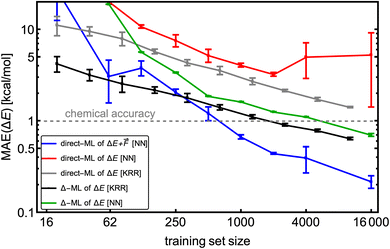 | ||
Fig. 4 The learning curves for training on the SA–W clusters while testing on the largest SA4W5 clusters excluded from the training. Different lines correspond to direct-/Δ-learning of KRR/NN model trained on  . The kernel-ridge-regression (KRR) results are taken from Kubečka et al.28 The error bars represent the standard deviation. Note the logarithmic axes. . The kernel-ridge-regression (KRR) results are taken from Kubečka et al.28 The error bars represent the standard deviation. Note the logarithmic axes. | ||
Interestingly, direct learning of the NN model appears to be more susceptible to initialization and data choice. The large variations in the direct learning of the NN model on energies (red line) for large training sizes indicate that this choice of hyperparameters makes the model very sensitive to the initial conditions, and a search for more suitable hyperparameters at these sizes would be beneficial. Chen et al.18 also demonstrated variation in their NN modeling (with NN model termed as VSpecNN) and suggested averaging over three independent NN models reduces MAEs of energies and forces by ∼30%.
Most importantly, NN computational times for larger training sizes significantly outperform the KRR times. Also, predictions of the NN model are orders of magnitude faster than for KRR, which scales quadratically with the training set size or even cubically for large sets.
3.2 The model performance
We trained three NN models on the full SA–WωB97X-D/6-31++G(d,p), SA–WB97-3c, and SA–AMB97-3c databases, while training on both energies and forces. Fig. 5 shows the evolutions of the loss function, which are mainly dependent on the model and system complexity and the learning rate. Both SA–W cases behave similarly as expected due to a high correlation between the B97-3c and ωB97X-D/6-31++G(d,p) binding energies. The SA–AM system also performs similarly to the SA–W cases as the SA–AM database complexity (cluster sizes and number of atom types) appears proportionally compensated by the NN model extension with one additional atomic feature set. All training runs clearly reached a plateau after 600 epochs. Each training took nearly three days using 1 GPU and 4 CPUs. All training and validations achieved mean absolute errors below 0.1 kcal mol−1. The best model (i.e., the model with the lowest validation loss) from each of the three training runs was subsequently used for testing. | ||
| Fig. 5 Training (blue) and validation (red) evolution of loss function for the full databases (∼18k) of the SA–W and SA–AM systems. | ||
For testing, we used the largest clusters in the database which were excluded from the training, i.e., SA4W5 for the SA–W systems and (SA8AM10, SA9AM10, and SA9AM11) for the SA–AM system. Fig. 6 shows the correlation of the NN-modeled and the QC-calculated energies and forces across all systems. For chemical predictions, these models are quite accurate with RMSD and MAE < 1 kcal mol−1, and with a very high correlation with the target method (PCC ≈ 1). The same applies to the force component predictions with RMSD and MAE < 1 kcal mol−1 Å−1 and force directions from angle deviation analysis with mean error < 1° (see SI-3†). In the case of SA–W, there is almost no apparent difference when modeling the two QC methods (ωB97X-D and B97-3c) due to their high correlation (see SI-4†). The SA–AM modeling shows only slightly larger MAE and RMSD than the SA–W modeling, likely for the same reasons as mentioned before, i.e., the SA–AM database complexity appears proportionally compensated by the NN model expansion. Similar to the previous section, note that all MAEs are slightly greater than the validation MAEs (see Fig. 5) as the testing is performed on the largest clusters while validation is performed on 10% of the data cut from the training database.
3.3 Application to large clusters
Here, we expand the above examination of the SA–AM model to even larger clusters and show the trend of MAEs with increasing cluster size. We took 25–50 random non-equilibrium clusters from the work of Wu et al.77 for each SAnAMn cluster size, where n ∈ 2–15. Note that we only used clusters smaller than SA10AM10 for the training. In Fig. 7, we observe that the MAEs of the electronic binding energies and force components are almost linearly increasing with cluster size. This proportionality to cluster size arises from the sum of atomic contributions, with each atom likely contributing with a similar error. Additionally, the molecules are differently polarized within the large clusters, which might not be well-captured by the NN model, resulting in increasing MAE of the force components as well slightly increased growth of MAEs of the energies for the SA10–15AM10–15 clusters. Nevertheless, the MAEs consistently remain below the chemical accuracy threshold of 1 kcal mol−1 or 1 kcal mol−1 Å−1.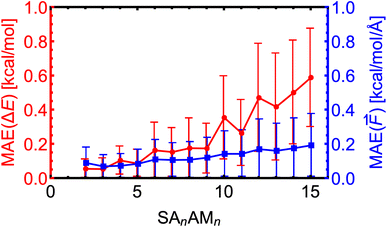 | ||
| Fig. 7 Absolute error distributions of the modeled energies and force components for the SAnAMn clusters trained at the B97-3c level. The error bars show the standard deviation. | ||
We have a fast method that quite accurately learns the reference QC method. Fig. 8 shows the typical computational times required for optimization and vibrational-frequency calculations for the SA–AM clusters during configurational sampling.77 Note that the times are multiplied by a factor of 8 as 8 CPUs were used even though the scaling of QC methods with the number of CPUs is not exactly linear. The frequency calculations take up approximately 15–50% of the computational time for the large clusters and up to 80% for the small. The scaling behavior of the B97-3c method is relatively moderate, exhibiting an almost linear trend in contrast to the poor scaling of other QC methods (e.g., ωB97X-D or even the coupled-cluster methods). Regardless, many such calculations must be performed during thorough configurational sampling, which is computationally demanding. Utilizing the above-trained NN model for SA–AM, we also show the times required for geometry optimization with the same optimization criteria as for the QC optimization (see Fig. 8). The final geometry will be close to the true minimum, but post-optimization at the target QC level has to be applied to reach the same geometry. For example, we performed configurational sampling and took one SA7AM7 structure optimized at GFN1-xTB. Subsequent optimization of this molecule at B97-3c (within ORCA) lasted 10 CPU-hours and required ∼80 iteration steps. The RMSD of the initial and final structure is 0.28 Å. Performing optimization (within ASE) with the trained NN takes 1 min per 100 iterations and approx. 100 iterations are required to reach the same optimization criteria as in the default settings of the ORCA program. The RMSD between both final structures is 0.04 Å, and with more iterations used in the NN optimization (300), the RMSD improvement is already negligible (lowered to 0.03 Å). When taking the NN-optimized structure, less than an extra 2 CPU-hours were required for B97-3c optimization to reach the minimum structure, which differs from the fully QC-optimized structure by ∼0.01 Å in RMSD (considered as the same geometry). Although there is already a 5-fold speed-up in a single optimization, there will be a massive overall speed-up by omitting numerous energetically high-lying configurations after the NN pre-optimization. This clearly underlines that NN techniques will play an important role in future studies of large molecular clusters.
3.4 Molecular-cluster dynamics via neural network
With an NN that can model forces, we can mimic Born–Oppenheimer molecular dynamics (BOMD) simulations of clusters at a significantly lower computational cost. We used the NN model from the previous section trained on SA–AMB97-3c to demonstrate this on a 100 ps long MD simulation. The simulations are performed using the Atomic Simulation Environment (ASE78,79), with a timestep of 0.1 fs, the Nosé–Hoover thermostat with friction frequency of 0.01 fs−1 and target temperatures (T) of 300 and 450 K. The entire 100 ps simulation only took ∼9 hours on 1 CPU. With reduced data dumping and a well-optimized simulation script, 1 ns simulation could be achieved within 1–3 CPU-days. Although the choice of thermostat or other parameters might not be ideal for real applications, this work aims to demonstrate the NN model's ability to quickly simulate large molecular clusters at the accuracy of a QC level of theory. Clearly, for MD simulations longer than a few picoseconds, the whole process of data generation, QC single-point and gradient calculation, NN training, and NN-boosted MD will become computationally faster than running BOMD at the QC level itself.Fig. 9a illustrates the time evolution of the electronic binding energy. 100 uniformly sampled (every 1 ps step) structures were recalculated at the B97-3c level to further validate the model. Fig. 9b shows a high correlation between NN-modeled and QC-re-calculated energies. A similar satisfactory correlation is observed for the force components (see SI-5†). At the low temperature (300 K), the MAE of 0.24 kcal mol−1 is similar to errors observed during the comparison for structures from Wu et al.77 (see Fig. 7). With higher temperature (450 K), the model performance is decreased and the MAE of 0.46 kcal mol−1 is almost twice as large as the MAE at the lower temperature. This can be attributed to the difference in data generation, and higher accuracy can be gained by expanding the database with appropriate structures. In other words, the training database was constructed by extracting structures from a short MD simulation at 300 K at GFN1-xTB (see Section 2.1), but MD simulations on the B97-3c potential energy surface and even at the higher temperature of 450 K will visit untrained parts of the configurational space. When we experimented with simulations at temperatures of 500 K or more, we experienced frequent simulation failures due to molecule fragmentation caused by inaccurate NN modeling. Nevertheless, below 500 K, the molecular cluster integrity remains unchanged during these simulations.
Even though the NN model maintains energy and force accuracy during the MD simulation, we also recommend examining whether other dynamics properties, such as radial distribution function and diffusivity, have been preserved (e.g., see the work of Fu et al.80). MD simulations can enhance our understanding of many cluster properties. For instance, we used the TRAVIS program81,82 to analyze the vibrations stored in the MD trajectory at 300 K. Fig. 10 demonstrates the analyzed power spectrum and compares it to the equilibrium harmonic vibrational frequencies of the lowest free energy SA7AM7 conformer. The QC harmonic interpretation of the vibrational frequencies is insufficient for these weakly bound clusters, crowded with many anharmonic and low-frequency vibrations.83 Hence, MD simulation becomes important for interpreting some cluster behaviors. PaiNN was also designed to model directional properties such as dipole moments and polarizabilities. Modeling these properties along the generated trajectory allows calculating IR or Raman molecular spectra from molecular dynamics simulations. However, we omit them as this is beyond the scope of the current work.
3.5 Large database reduction
To construct a large database, we utilize the Clusteromics I–V databases (see Fig. 1). Electronic binding energies (ΔE) of these data were calculated at the r2SCAN-3c36 and GFN1-xTB50,51 levels, making them suitable for Δ-ML. Knattrup et al.32 used 5-fold cross-validation and showed that the KRR model could reach MAEs lower than 1 kcal mol−1 for each Clusteromics separately when trained on very few data (∼50–100). Note that the KRR-model error is low (compared to KRR modeling in Fig. 4) as the test/validation is also performed on small clusters, i.e., not only the largest clusters in the database. Knattrup et al.32 reported difficulties related to computational times for their large (>1k) training databases. Here, we performed similar training of the NN model (training for 1000 epochs) for each training set size and evaluated the model on the entire corresponding Clusteromics dataset. In Fig. 11, we demonstrate that the NN model again does not outperform the KRR model but consistently reaches the chemical accuracy of 1 kcal mol−1 for each Clusteromics set, with a training set requiring at least 2k of random data. We used the same ‘optimal’ hyperparameters of the NN model as in the previous sections, i.e., optimized for slightly different systems, which is likely why the NN model reaches MAEs of 1 kcal mol−1 for 2k training dataset while the KRR model reaches 0.2 kcal mol−1. The KRR has a large advantage when tested on data similar to the training data. Testing on structures that are different from the training database would potentially make the KRR and NN performance more comparable for large training sets. Nevertheless, training and validation times for NN modeling again outperform KRR and are no longer the main bottleneck of ML model applications. For instance, predicting 1000 energies with the trained NN model takes a few minutes using 1 CPU, outperforming KRR by orders of magnitudes, which requires days and many CPUs for training databases with more than 1k structures.The Clusteromics I–V database combined into one ∼221k large Clusterome database32 offers a playground for data filtering/reduction. Fig. 11 demonstrates our ability to train the NN model for significantly larger training sizes than the KRR model. Despite only performing one training for each training set size, we see a smooth decrease in MAE down to ∼0.3 kcal mol−1 for the 64k training dataset. Due to computational times, we have added the 128k and full Clusteromics MAE only based on the 100-epoch performance relative to the 64k database. Surprisingly, the MAEs are not much worse than in the case of separate Clusteromics modelings, likely due to the fact that the accuracy of electronic binding energies is mainly driven by the description of hydrogen bonds across all the Clusteromics datasets.
Finally, we applied the database reduction/active learning (AL) procedure presented by Smith et al.56 We took 0.25k data, trained the NN model, and used the predictions on the full Clusteromics database to identify the next potential candidates for training. Here, we use the terms supervised AL, where we obtain the errors by comparing the predicted ΔE value to the true r2SCAN-3c value, and unsupervised AL, where we obtain the errors as the standard deviation of the predicted ΔE values between three NN models (also known as ‘query by committee’), initiated with different RNG seeds. The worst performing 0.25k data are added to the training set for the next iteration, where the NN model is again fully trained from scratch. Fig. 11 shows that the two methods (red and brown lines) are sensitive to the choice of the first 0.25k data but perform quite similarly after a few iterations. Unfortunately, they do not seem to perform better than the random sampling (green line). We even tested a random sampling of 0.25k data from the worst-performing systems (e.g., with error threshold >1 kcal mol−1) and continued training the NN model from the previous step (i.e., no training from scratch) with no significant differences. We believe the database reduction will not significantly reduce MAEs for systems with similar chemical features. The driving mechanism of cluster formation is hydrogen bonding. The more training data, the more accurate the NN model. However, perhaps no particular outliers introduce hard-to-model hydrogen bonds or offer a significantly greater improvement when introduced to the training set. In SI-6,† we used KRR and tested the active learning on a small database (0.25k). There, active learning reduces the MAE by a factor of <1.5 compared to random sampling. However, active learning even reduces the maximum error by a factor of ∼2. Another option to test in the future would be selecting the worst MAEs per atom.
To conclude, although active learning appears to offer only a small MAE improvement for molecular clusters, it can help to eliminate outliers.
4 Conclusion
We used several databases of quantum chemistry (QC) data for typical atmospheric molecular clusters and showed that machine learning could easily substitute the computationally demanding QC calculations. Specifically, we used the polarizable atom interaction neural network (PaiNN) to model the cluster's binding energies, both with or without interatomic forces. We show that hyperparameter variation (e.g., reducing batch size) leads to faster converging NN training without compromising accuracy. We demonstrate that NNs do not outperform the accuracy of the KRR modeling by Kubečka et al.,28 but the computational times for NNs are significantly lower. Similar to the case of KRR modeling, we find that Δ-learning improves the accuracy ∼4-fold. We use the energies and interatomic forces to train NN models for sulfuric acid–water clusters and sulfuric acid–ammonia clusters with quite reliable performance compared to the trained QC methods even when tested on larger structures excluded from the training: mean absolute errors of <0.26 kcal mol−1 for energies and <0.18 kcal mol−1 Å−1 for force components, and root mean squared displacements of <0.34 kcal mol−1 and ∼0.30 kcal mol−1 Å−1, respectively.Furthermore, we show that these NN models will be very useful for application in configurational samplings of larger molecular clusters, as the atomic error contribution remains constant with increasing cluster size. While single-point energy evaluation at a high-level QC level for large clusters, with ten or more molecules, takes hours and often more than a day, the same evaluation with NN is nearly instant (∼seconds). We demonstrated this by comparing B97-3c and the NN model and showed the model's ability to optimize geometries and reproduce the B97-3c close-to-equilibrium structures.
Finally, we tested database reduction methods employing supervised and unsupervised active learning. The data reduction slightly improves the NN model performance for the same data sizes compared to random selection. We speculate that this could be caused by the fact that the driving mechanism of cluster binding is hydrogen bonding, which gets better described with more data, but there is no particular data that would introduce hard-to-model hydrogen bonds. Nevertheless, active learning appears to be a suitable tool for eliminating outliers. Furthermore, we find that the NN model trained only on energy, using Δ-learning, is able to utilize significantly more data than our previous KRR model.32 While we again confirm that KRR performs better for smaller sizes, NNs also can reach MAEs lower than chemical accuracy of 1 kcal mol−1, while outperforming KRR with respect to the computational times required for both training and predictions. We envision utilizing NN models for a better understanding of cluster dynamics. This includes cluster rigidity, reorganization after formation, reorganization before fragmentation, or even reactions within the cluster or on its surface. Overall, we believe that NN modeling will play a pivotal role in future studies of atmospheric molecular clusters.
Data availability
All computational programs are cited within the article. Additionally, software Mathematica was used for plotting graphs and molecule visualization. All our scripts are available on GitHub (referenced in ESI†) as well as the processed data used for ML training and result data from analysis.Author contributions
Conceptualization: JK, ZT, JE; data curation: JK, YK; formal analysis: JK, DA, YK; funding acquisition: JK, JE, ZT; investigation: JK, DA; methodology: JK, DA, YK; project administration: JK; software: JK, ZT, DA, ME, HW; resources: JE; supervision: JE; validation: JK, DA; visualization: JK; writing – original draft: JK, JE; writing – review & editing: YK, ZT, DA, ME, HW.Conflicts of interest
All authors declare that they have no conflicts of interest.Acknowledgements
Funded by the European Union (MSCA, HYDRO-CLUSTER, project 101105506, and ERC, ExploreFNP, project 101040353), by the Danish National Research Foundation through the Center of Excellence (InterCat, project DNRF150) and through the Center of Excellence for Chemistry of Clouds (DNRF172), by the Independent Research Fund Denmark (9064-00001B), and by the VILLUM FONDEN (Investigator grant, project 16562). Views and opinions expressed are however those of the authors only and do not necessarily reflect those of the European Union or the European Research Council Executive Agency. Neither the European Union nor the granting authority can be held responsible for them. The numerical results presented in this work were obtained at the Centre for Scientific Computing, Aarhus https://phys.au.dk/forskning/faciliteter/cscaa/.References
- G. Myhre, C. Lund Myhre, B. H. Samset and T. Storelvmo, Aerosols and their Relation to Global Climate and Climate Sensitivity, Nat. Sci. Educ., 2013, 4, 7 Search PubMed.
- J. Merikanto, D. V. Spracklen, G. W. Mann, S. J. Pickering and K. S. Carslaw, Impact of nucleation on global CCN, Atmos. Chem. Phys., 2009, 9, 8601–8616 CrossRef CAS.
- J. Tröstl, W. K. Chuang, H. Gordon, M. Heinritzi, C. Yan, U. Molteni, L. Ahlm, C. Frege, F. Bianchi and R. Wagner, et al., The Role of Low-volatility Organic Compounds in Initial Particle Growth in the Atmosphere, Nature, 2016, 533, 527–531 CrossRef PubMed.
- C. I. Falcon-Rodriguez, A. Osornio-Vargas, I. Sada-Ovalle and P. Segura-Medina, Aeroparticles, composition, and lung diseases, Front. Immunol., 2016, 7, 1–9 Search PubMed.
- M. Mei, H. Song, L. Chen, B. Hu, R. Bai, D. Xu, Y. Liu, Y. Zhao and C. Chen, Early-life exposure to three size-fractionated ultrafine and fine atmospheric particulates in Beijing exacerbates asthma development in mature mice, Part. Fibre Toxicol., 2018, 15, 13 CrossRef PubMed.
- World Health Organization (WHO), Ambient (outdoor) air pollution, 2022, https://www.who.int/news-room/fact-sheets/detail/ambient-(outdoor)-air-quality-and-health, (accessed February 7, 2023).
- K. Lehtipalo, C. Yan, L. Dada, F. Bianchi, M. Xiao, R. Wagner, D. Stolzenburg, L. R. Ahonen, A. Amorim and A. Baccarini, et al., Multicomponent new particle formation from sulfuric acid, ammonia, and biogenic vapors, Sci. Adv., 2018, 4, eaau5363 CrossRef CAS PubMed.
- S. Yang, Z. Liu, P. S. Clusius, Y. Liu, J. Zou, Y. Yang, S. Zhao, G. Zhang, Z. Xu and Z. Ma, et al., Chemistry of new particle formation and growth events during wintertime in suburban area of Beijing: Insights from highly polluted atmosphere, Atmos. Res., 2021, 255, 105553 CrossRef CAS.
- F. R. Nursanto, R. Meinen, R. Holzinger, M. C. Krol, X. Liu, U. Dusek, B. Henzing and J. L. Fry, What Chemical Species Are Responsible for New Particle Formation and Growth in the Netherlands? A Hybrid Positive Matrix Factorization (PMF) Analysis Using Aerosol Composition (ACSM) and Size (SMPS), EGUsphere, 2023, vol. 2023, pp. 1–22 Search PubMed.
- M. Peltola, C. Rose, J. V. Trueblood, S. Gray, M. Harvey and K. Sellegri, Chemical precursors of new particle formation in coastal New Zealand, Atmos. Chem. Phys., 2023, 23, 3955–3983 CrossRef CAS.
- J. Elm, J. Kubečka, V. Besel, M. J. Jääskeläinen, R. Halonen, T. Kurtén and H. Vehkamäki, Modeling the formation and growth of atmospheric molecular clusters: A review, J. Aerosol Sci., 2020, 149, 105621 CrossRef CAS.
- J. Elm, D. Ayoubi, M. Engsvang, A. B. Jensen, Y. Knattrup, J. Kubčeka, C. J. Bready, V. R. Fowler, S. E. Harold and O. M. Longsworth, et al., Quantum chemical modeling of organic enhanced atmospheric nucleation: A critical review, Wiley Interdiscip. Rev.: Comput. Mol. Sci., 2023, 13, e1662 CAS.
- M. Engsvang, H. Wu, Y. Knattrup, J. Kubečka, A. B. Jensen and J. Elm, Quantum chemical modeling of atmospheric molecular clusters involving inorganic acids and methanesulfonic acid, Chem. Phys. Rev., 2023, 4, 031311 CrossRef CAS.
- A. M. Turing, Computing Machinery and Intelligence, Mind, 1950, 49, 460 Search PubMed.
- J. A. Keith, V. Vassilev-Galindo, B. Cheng, S. Chmiela, M. Gastegger, K.-R. Müller and A. Tkatchenko, Combining Machine Learning and Computational Chemistry for Predictive Insights Into Chemical Systems, Chem. Rev., 2021, 121, 9816–9872 CrossRef CAS PubMed.
- M. Meuwly, Machine Learning for Chemical Reactions, Chem. Rev., 2021, 121, 10218–10239 CrossRef CAS PubMed.
- D. Kuntz and A. K. Wilson, Machine learning, artificial intelligence, and chemistry: How smart algorithms are reshaping simulation and the laboratory, Pure Appl. Chem., 2022, 94, 1019–1054 CrossRef CAS.
- Y. Chen, S. V. Pios, M. F. Gelin and L. Chen, Accelerating Molecular Vibrational Spectra Simulations with a Physically Informed Deep Learning Model, J. Chem. Theory Comput., 2024, 20(11), 4703–4710 CrossRef PubMed.
- A. R. Katritzky, M. Kuanar, S. Slavov, C. D. Hall, M. Karelson, I. Kahn and D. A. Dobchev, Quantitative Correlation of Physical and Chemical Properties with Chemical Structure: Utility for Prediction, Chem. Rev., 2010, 110, 5714–5789 CrossRef CAS PubMed.
- E. N. Muratov, J. Bajorath, R. P. Sheridan, I. V. Tetko, D. Filimonov, V. Poroikov, T. I. Oprea, I. I. Baskin, A. Varnek and A. Roitberg, et al., QSAR without borders, Chem. Soc. Rev., 2020, 49, 3525–3564 RSC.
- E. Lumiaro, M. Todorović, T. Kurten, H. Vehkamäki and P. Rinke, Predicting gas–particle partitioning coefficients of atmospheric molecules with machine learning, Atmos. Chem. Phys., 2021, 21, 13227–13246 CrossRef CAS.
- A. Gupta, M. Stulajter, Y. Shaidu, J. Neaton and W. de Jong, Equivariant Neural Networks Utilizing Molecular Clusters for Accurate Molecular Crystal Binding Energy Predictions, ChemRxiv, 2023, preprint, DOI:10.26434/chemrxiv-2023-vk9gh.
- N. Hyttinen, A. Pihlajamäki and H. Häkkinen, Machine Learning for Predicting Chemical Potentials of Multifunctional Organic Compounds in Atmospherically Relevant Solutions, J. Phys. Chem. Lett., 2022, 13, 9928–9933 CrossRef CAS PubMed.
- S. Jiang, Y.-R. Liu, T. Huang, Y.-J. Feng, C.-Y. Wang, Z.-Q. Wang, B.-J. Ge, Q.-S. Liu, W.-R. Guang and W. Huang, Towards fully ab initio simulation of atmospheric aerosol nucleation, Nat. Commun., 2022, 13, 6067 CrossRef CAS PubMed.
- V. Besel, M. Todorović, T. Kurtén, H. Vehkamäki and P. Rinke, The search for sparse data in molecular datasets: Application of active learning to identify extremely low volatile organic compounds, J. Aerosol Sci., 2024, 179, 106375 CrossRef CAS.
- N. J. Browning, F. A. Faber and O. A. von Lilienfeld, GPU-accelerated approximate kernel method for quantum machine learning, J. Chem. Phys., 2022, 157, 214801 CrossRef CAS PubMed.
- A. S. Christensen, F. A. Faber, B. Huang, L. A. Bratholm, A. Tkatchenko, K. R. Muller and O. A. von Lilienfeld, QML: A Python Toolkit for Quantum Machine Learning, 2017, https://github.com/qmlcode/qml.
- J. Kubečka, A. S. Christensen, F. R. Rasmussen and J. Elm, Quantum Machine Learning Approach for Studying Atmospheric Cluster Formation, Environ. Sci. Technol. Lett., 2022, 9, 239–244 CrossRef.
- M. Engsvang, J. Kubečka and J. Elm, Toward Modeling the Growth of Large Atmospheric Sulfuric Acid–Ammonia Clusters, ACS Omega, 2023, 8, 34597–34609 CrossRef CAS PubMed.
- J. Kubečka, I. Neefjes, V. Besel, F. Qiao, H. B. Xie and J. Elm, Atmospheric Sulfuric Acid-Multi-Base New Particle Formation Revealed through Quantum Chemistry Enhanced by Machine Learning, J. Phys. Chem. A, 2023, 127, 2091–2103 CrossRef PubMed.
- J. Kubečka, Y. Knattrup, M. Engsvang, A. B. Jensen, D. Ayoubi, H. Wu, O. Christiansen and J. Elm, Current and future machine learning approaches for modeling atmospheric cluster formation, Nat. Comput. Sci., 2023, 3, 495–503 CrossRef PubMed.
- Y. Knattrup, J. Kubečka, D. Ayoubi and J. Elm, Clusterome: A Comprehensive Data Set of Atmospheric Molecular Clusters for Machine Learning Applications, ACS Omega, 2023, 8, 25155–25164 CrossRef CAS PubMed.
- J. Kubečka, V. Besel, I. Neefjes, Y. Knattrup, T. Kurtén, H. Vehkamäki and J. Elm, Computational Tools for Handling Molecular Clusters: Configurational Sampling, Storage, Analysis, and Machine Learning, ACS Omega, 2023, 8, 45115–45128 CrossRef PubMed.
- Y. Knattrup, J. Kubečka and J. Elm, Nitric Acid and Organic Acids Suppress the Role of Methanesulfonic Acid in Atmospheric New Particle Formation, J. Phys. Chem. A, 2023, 127, 7568–7578 CrossRef CAS PubMed.
- J. G. Brandenburg, C. Bannwarth, A. Hansen and S. Grimme, B97-3c: A revised low-cost variant of the B97-D density functional method, J. Chem. Phys., 2018, 148, 064104 CrossRef PubMed.
- S. Grimme, A. Hansen, S. Ehlert and J. Mewes, r2SCAN-3c: A “Swiss army knife” composite electronic-structure method, J. Chem. Phys., 2021, 154, 064103 CrossRef CAS PubMed.
- K. T. Schütt, O. T. Unke and M. Gastegger, Equivariant Message Passing for the Prediction of Tensorial Properties and Molecular Spectra, 2021 Search PubMed.
- K. T. Schütt, P. Kessel, M. Gastegger, K. A. Nicoli, A. Tkatchenko and K. Müller, SchNetPack: A Deep Learning Toolbox For Atomistic Systems, J. Chem. Theory Comput., 2019, 15, 448–455 CrossRef PubMed.
- K. T. Schütt, S. S. P. Hessmann, N. W. A. Gebauer, J. Lederer and M. Gastegger, SchNetPack 2.0: A neural network toolbox for atomistic machine learning, J. Chem. Phys., 2023, 158, 144801 CrossRef PubMed.
- J. V. Kildgaard, K. V. Mikkelsen, M. Bilde and J. Elm, Hydration of Atmospheric Molecular Clusters: A New Method for Systematic Configurational Sampling, J. Phys. Chem. A, 2018, 122, 5026–5036 CrossRef CAS PubMed.
- F. R. Rasmussen, J. Kubečka, V. Besel, H. Vehkamäki, K. V. Mikkelsen, M. Bilde and J. Elm, Hydration of Atmospheric Molecular Clusters III: Procedure for Efficient Free Energy Surface Exploration of Large Hydrated Clusters, J. Phys. Chem. A, 2020, 124, 5253–5261 CrossRef CAS PubMed.
- J. Kubečka, V. Besel, T. Kurtén, N. Myllys and H. Vehkamäki, Configurational Sampling of Noncovalent (Atmospheric) Molecular Clusters: Sulfuric Acid and Guanidine, J. Phys. Chem. A, 2019, 123, 6022–6033 CrossRef PubMed.
- V. Besel, J. Kubečka, T. Kurtén and H. Vehkamäki, Impact of Quantum Chemistry Parameter Choices and Cluster Distribution Model Settings on Modeled Atmospheric Particle Formation Rates, J. Phys. Chem. A, 2019, 124, 5931–5943 CrossRef PubMed.
- S. S. Xantheas and T. H. Dunning, AbInitio Studies of Cyclic Water Clusters (H2O)n, n = 1-6. I. Optimal Structures and Vibrational Spectra, J. Chem. Phys., 1993, 99, 8774–8792 CrossRef CAS.
- S. S. Xantheas, AbInitio Studies of Cyclic Water Clusters (H2O)n, n = 1-6. II. Analysis of Many-body Interactions, J. Chem. Phys., 1994, 100, 7523–7534 CrossRef CAS.
- S. S. Xantheas, AbInitio Studies of Cyclic Water Clusters (H2O)n, n = 1-6. III. Comparison of Density Functional with MP2 Results, J. Chem. Phys., 1995, 102, 4505–4517 CrossRef CAS.
- B. Temelso, K. A. Archer and G. C. Shields, Benchmark Structures and Binding Energies of Small Water Clusters with Anharmonicity Corrections, J. Phys. Chem. A, 2011, 115, 12034–12046 CrossRef CAS PubMed.
- D. Manna, M. K. Kesharwani, N. Sylvetsky and J. M. L. Martin, Conventional and Explicitly Correlated ab Initio Benchmark Study on Water Clusters: Revision of the BEGDB and WATER27 Data Sets, J. Chem. Theory Comput., 2017, 13, 3136–3152 CrossRef CAS PubMed.
- J.-D. Chai and M. Head-Gordon, Long-range corrected hybrid density functionals with damped atom-atom dispersion corrections, Phys. Chem. Chem. Phys., 2008, 10, 6615–6620 RSC.
- S. Grimme, C. Bannwarth and P. Shushkov, A robust and accurate tight-binding quantum chemical method for structures, vibrational frequencies, and noncovalent interactions of large molecular systems parametrized for all spd-block elements (Z = 1-86), J. Chem. Theory Comput., 2017, 13, 1989–2009 CrossRef CAS PubMed.
- P. Pracht, E. Caldeweyher, S. Ehlert and S. Grimme, A robust non-self-consistent tight-binding quantum chemistry method for large molecules, ChemrXiv, 2019, preprint, pp. 1–19. https://chemrxiv.org/engage/chemrxiv/article-details/60c742abbdbb890c7ba3851a Search PubMed.
- J. Elm, Clusteromics I: Principles, Protocols and Applications to Sulfuric Acid – Base Cluster Formation, ACS Omega, 2021, 6, 7804–7814 CrossRef CAS PubMed.
- J. Elm, Clusteromics II: Methanesulfonic Acid-Base Cluster Formation, ACS Omega, 2021, 6, 17035–17044 CrossRef CAS PubMed.
- Y. Knattrup and J. Elm, Clusteromics IV: The Role of Nitric Acid in Atmospheric Cluster Formation, ACS Omega, 2022, 7, 31551–31560 CrossRef CAS PubMed.
- D. Ayoubi, Y. Knattrup and J. Elm, Clusteromics V: Organic Enhanced Atmospheric Cluster Formation, ACS Omega, 2023, 8, 9621–9629 CrossRef CAS PubMed.
- J. S. Smith, B. Nebgen, N. Lubbers, O. Isayev and A. E. Roitberg, Less is more: Sampling chemical space with active learning, J. Chem. Phys., 2018, 148, 241733 CrossRef PubMed.
- C. Bannwarth, S. Ehlert, A. Hansen, P. Pracht, J. Seibert, S. Spicher and S. Grimme, Extended tight-binding quantum chemistry methods, Wiley Interdiscip. Rev.: Comput. Mol. Sci., 2020, e01493 Search PubMed.
- M. J. Frisch, G. W. Trucks, H. B. Schlegel, G. E. Scuseria, M. A. Robb, J. R. Cheeseman, G. Scalmani, V. Barone, G. A. Petersson, H. Nakatsuji, et al., Gaussian 16 Revision A.03, Gaussian Inc., Wallingford CT, 2016 Search PubMed.
- F. Neese, The ORCA program system, Wiley Interdiscip. Rev.: Comput. Mol. Sci., 2012, 2, 73–78 CAS.
- F. Neese, Software update: The ORCA program system, version 4.0, Wiley Interdiscip. Rev.: Comput. Mol. Sci., 2018, 8, e1327 Search PubMed.
- P. L. Houston, C. Qu, Q. Yu, P. Pandey, R. Conte, A. Nandi, J. M. Bowman and S. G. Kukolich, Formic Acid–Ammonia Heterodimer: A New Δ-Machine Learning CCSD(T)-Level Potential Energy Surface Allows Investigation of the Double Proton Transfer, J. Chem. Theory Comput., 2024, 20, 1821–1828 CrossRef CAS PubMed.
- J. M. Bowman, C. Qu, R. Conte, A. Nandi, P. L. Houston and Q. Yu, Δ-Machine Learned Potential Energy Surfaces and Force Fields, J. Chem. Theory Comput., 2023, 19, 1–17 CrossRef CAS PubMed.
- A. Nandi, C. Qu, P. L. Houston, R. Conte and J. M. Bowman, Δ-machine learning for potential energy surfaces: A PIP approach to bring a DFT-based PES to CCSD(T) level of theory, J. Chem. Phys., 2021, 154, 051102 CrossRef CAS PubMed.
- S. Wengert, G. Csányi, K. Reuter and J. T. Margraf, A Hybrid Machine Learning Approach for Structure Stability Prediction in Molecular Co-crystal Screenings, J. Chem. Theory Comput., 2022, 18, 4586–4593 CrossRef CAS PubMed.
- R. Ramakrishnan, P. O. Dral, M. Rupp and O. A. von Lilienfeld, Big Data Meets Quantum Chemistry Approximations: The Δ-Machine Learning Approach, J. Chem. Theory Comput., 2015, 11, 2087–2096 CrossRef CAS PubMed.
- K. T. Schütt, P. Kindermans, H. E. Sauceda, S. Chmiela, A. Tkatchenko and K. Müller, SchNet: A Continuous-Filter Convolutional Neural Network for Modeling Quantum Interactions, 2017 Search PubMed.
- Y.-L. Liao and T. Smidt, Equiformer: Equivariant Graph Attention Transformer for 3D Atomistic Graphs, The Eleventh International Conference on Learning Representations, 2023 Search PubMed.
- P. Thölke and G. D. Fabritiis, Equivariant Transformers for Neural Network based Molecular Potentials. International Conference on Learning Representations, 2022 Search PubMed.
- S. Batzner, A. Musaelian, L. Sun, M. Geiger, J. P. Mailoa, M. Kornbluth, N. Molinarim, T. E. Smidt and B. Kozinsky, E(3)-equivariant graph neural networks for data-efficient and accurate interatomic potentials, Nat. Commun., 2022, 13, 1–11 Search PubMed.
- C. Darken, J. Chang and J. Moody, Learning rate schedules for faster stochastic gradient search, Neural Networks for Signal Processing II Proceedings of the 1992 IEEE Workshop, 1992, pp 3–12 Search PubMed.
- J. Xia, Y. Zhang and B. Jiang, Accuracy Assessment of Atomistic Neural Network Potentials: The Impact of Cutoff Radius and Message Passing, J. Phys. Chem. A, 2023, 127, 9874–9883 CrossRef CAS PubMed.
- O. T. Unke and M. Meuwly, PhysNet: A Neural Network for Predicting Energies, Forces, Dipole Moments, and Partial Charges, J. Chem. Theory Comput., 2019, 15, 3678–3693 CrossRef CAS PubMed.
- O. T. Unke, S. Chmiela, M. Gastegger, K. T. Schütt, H. E. Sauceda and K.-E. Müller, SpookyNet: Learning force fields with electronic degrees of freedom and nonlocal effects, Nat. Commun., 2021, 12, 7273 CrossRef CAS PubMed.
- J. Westermayr, S. Chaudhuri, A. Jeindl, O. T. Hofmann and R. J. Maurer, Long-range dispersion-inclusive machine learning potentials for structure search and optimization of hybrid organic–inorganic interfaces, Digital Discovery, 2022, 1, 463–475 RSC.
- D. Anstine, R. Zubatyuk and O. Isayev, AIMNet2: A Neural Network Potential to Meet your Neutral, Charged, Organic, and Elemental-Organic Needs, ChemRxiv, 2023, preprint, DOI:10.26434/chemrxiv-2023-296ch.
- D. Kingma and J. Ba, Adam: A Method for Stochastic Optimization, International Conference on Learning Representations (ICLR), San Diega, CA, USA, 2015 Search PubMed.
- H. Wu, M. Engsvang, Y. Knattrup, J. Kubečka and J. Elm, Improved Configurational Sampling Protocol for Large Atmospheric Molecular Clusters, ACS Omega, 2023, 8, 45065–45077 CrossRef CAS PubMed.
- A. H. Larsen, J. J. Mortensen, J. Blomqvist, I. E. Castelli, R. Christensen, M. Dułak, J. Friis, M. N. Groves, B. Hammer and C. Hargus, et al., The atomic simulation environment—a Python library for working with atoms, J. Condens. Matter Phys., 2017, 29, 273002 CrossRef PubMed.
- S. R. Bahn and K. W. Jacobsen, An object-oriented scripting interface to a legacy electronic structure code, Comput. Sci. Eng., 2002, 4, 56–66 CrossRef CAS.
- X. Fu, Z. Wu, W. Wang, T. Xie, S. Keten, R. Gomez-Bombarelli and T. Jaakkola, Forces Are Not Enough: Benchmark and Critical Evaluation for Machine Learning Force Fields with Molecular Simulations. 2023 Search PubMed.
- M. Brehm, M. Thomas, S. Gehrke and B. Kirchner, TRAVIS—A free analyzer for trajectories from molecular simulation, J. Chem. Phys., 2020, 152, 164105 CrossRef CAS PubMed.
- M. Brehm and B. Kirchner, TRAVIS – A Free Analyzer and Visualizer for Monte Carlo and Molecular Dynamics Trajectories, J. Chem. Inf. Model., 2011, 51, 2007–2023 CrossRef CAS PubMed.
- D. R. Galimberti and J. Sauer, Chemically Accurate Vibrational Free Energies of Adsorption from Density Functional Theory Molecular Dynamics: Alkanes in Zeolites, J. Chem. Theory Comput., 2021, 17, 5849–5862 CrossRef CAS PubMed.
Footnote |
| † Electronic supplementary information (ESI) available: SI-1 – package and data availability, SI-2 – rankings of hyperparameter optimization searches, SI-3 – force vector angle deviation analysis, SI-4 – ωB97X-D/6-31++G(d,p) and B97-3c correlation, SI-5 – performance of force modeling, SI-6 – data reduction test. See DOI: https://doi.org/10.1039/d4va00255e |
| This journal is © The Royal Society of Chemistry 2024 |

